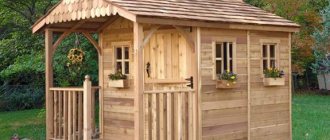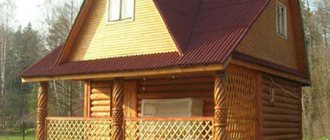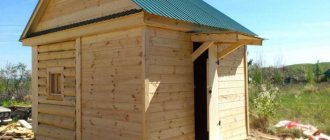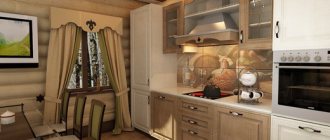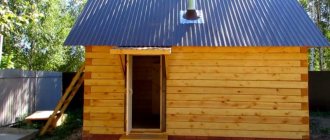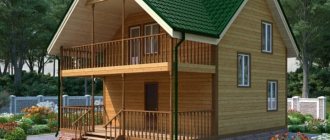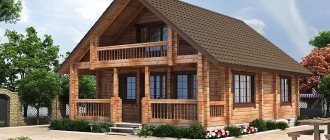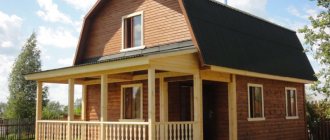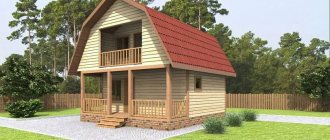Having your own bathhouse on site is the dream of many. It’s nice to come at any time and take a steam bath with a broom, then drink tea on the veranda, without having to time it, because every hour of visiting is paid. In addition, today the choice of building materials is rich and varied, so building a bathhouse yourself is not so expensive.
The bathhouse can have different sizes; you should choose based on the size of the area, budget and the number of people who will go to take a steam bath. The 4x5 m bathhouse project is one of the most popular options, which is close to the ideal - the 6x4 m bathhouse project.
Beautiful examples
Often, in order to decide what you want, you need to look at some examples.
A good option for a sauna with a swimming pool. As you can see, the steam room does not take up much space here
Pay attention to the doors. From the steam room you will go to the locker room or pool (depending on whether you want to continue the bath procedures or finish)
From there you can go to the bathroom. There are no direct passages from the steam room to the relaxation room or pool. This is done to ensure that hot air from the steam room does not hit the electronics and does not mix with room temperature air. If you do not have such a large room, take a look at the next option. It is designed for a 5x4 bath and includes only everything you need. As you can see, the shower room here can also be used as a changing room. Pay attention to the doors again - the steam room does not have direct access to the relaxation room.
For more information on the intricacies of bathhouse planning, watch the following video.
What materials can you choose for construction?
Most often you can find bathhouses made of wood in private areas. However, depending on the layout of the bathhouse 4x6 or other sizes, the choice of materials may vary.
Bathhouse layout option 4 by 6 meters
A selection of options for planning a steam room in a bathhouse. Most often, they rely on the following types of raw materials for construction:
- Frame bath. Such material can be collected either with your own hands or with the help of professional builders. In any case, the assembly is quite simple, so even with the smallest skills in this vein, you can implement the idea and see the desired result. This material comes in the form of ready-made beams that can be assembled together without much difficulty.
The process of assembling a frame bath - Paving stones. This raw material is quite expensive. When constructing a steam room yourself from such material, you need to ensure that each element is firmly connected to each other. The money spent will be returned along with the wonderful emotions that arise at the sight of such a noble and rich building.
- Logs. If the bet is made in favor of such a material, then there is no need for additional costs for internal and external insulation of the bathhouse. Such raw materials are considered reliable and durable. The main thing is to properly care for the material.
Project and exterior of a log bathhouse
Foundation for the construction of a bathhouse
The dimensions and total weight of the 4x6 bath indicate that a permanent foundation is needed. In this case, there is no alternative to a strip foundation. But still, projects with a columnar base are often found. This is acceptable, but it is necessary to mount the supports more often. According to the regulations, they are installed every two meters, and to increase strength, you can reduce the distance. Just don’t place the pillars closer than 1 meter from each other. This can lead to soil collapse and loss of bearing capacity of the foundation.
An option with screw piles is also allowed, but only on the condition that the roof structure will not exert additional load. In this option, the supports can be screwed in every 50–70 cm. This arrangement will give the pile foundation high strength.
At the stage of laying the foundation, all communication channels are carried out. A bathhouse of 4x6 meters will be capital, and building a room of this size for seasonal use is simply stupid. Therefore, when laying the foundation, all lines are drawn. Sleeves for pipelines and sewerage are mounted in a tape or fixed between pile supports. After assembling the log house, all supply lines will need to be insulated. But this work is carried out only after the roof for the bathhouse has been erected.
At this stage, the location of the sauna stove is also modeled. If you decide to use devices that run on electric heating elements for heating, then you don’t need to do anything. They are installed upon completion of construction. The stove-stove is laid on a pre-prepared base. The foundation must be made in advance. The stove is installed after the walls are erected.
Washing
The area of the washing compartment must be calculated based on 1 m/sq. per person. Of course, if you wish, you can either increase or decrease the area of this room. The size of the sink can be planned in principle to any size at the owner’s request), but from practice it is recommended to make this room no more than 2 meters. A larger sink would simply not be practical. With this layout, it is possible to additionally install benches for placing bath accessories.
Advice.
It is imperative to install ventilation in this compartment. Install vents or a full window.
To ensure that the room is well ventilated, some builders think about the placement of ventilation in the floor and ceiling, so that there will be a constant flow of fresh air in the room with good circulation. This is very important in order to get rid of dampness and in the case of wooden floors to prevent rotting of the wood. If the decoration is made of ceramic tiles, then a window will be enough.
Small and big
The smaller the sauna, is its heating more economical? Not always like this. It’s good if the dimensions of the bathhouse allow you to place the stove not close to the outer wall without compromising the ergonomics of the room.
The outer wall next to the heating device will take a lot of heat (part of it will return, but one or another portion of the heat will be lost forever).
It is better to place the stove at a distance of 20 cm from its fence (usually metal, lined with heat-resistant wood on the outside). Both oven inspection and cleaning will be simplified.
For a large bathhouse, one heat source may not be enough, then two stoves, or a heater and a fireplace, are installed in adjacent rooms. Combustion products are discharged by one common chimney.
The maximum possible size of the building is determined by the territory.
The dacha plot is spacious, are there several options for the location of the future bathhouse? The choice should fall on the most convenient and “right” place:
- it’s good if it’s elevated - the organization of drainage will be easier;
- if possible, away from the road;
- close to existing communications;
- fenced off from neighboring areas by other buildings (friendly neighbors come to an agreement, build bathhouses nearby and combine sewerage);
- allows the bathhouse to avoid being closely surrounded by flammable structures, bushes, and trees.
The choice of the final dimensions of the frame bath can be influenced by the dimensions of the cladding elements and the filling of the frame. Building components made from wood materials - sheets, slabs - can be cut with power tools without much difficulty.
It is easier to use whole products. (You will still have to divide some of the materials: they should be attached to the frame so that a whole sheet of the next one is located above the joint of adjacent sheets of one row).
Therefore, the length of the wall often turns out to be a multiple of the length of the sheet (slab) or half the length, taking into account the technological gaps of the cladding.
For example, when building a 5 × 5 bathhouse, frame walls can be sheathed with OSB 250 × 125 (cm):
- sheathing length: 250 + 1 + 250 = 501 (cm);
- height: 125 × 1 × 125 = 251 (cm).
Based on the width of the insulation slabs (mats) (for example, 60 cm) and the thickness of the frame posts (5 cm), we obtain: a 3 × 5 building can have a frame length of one wall of 5 + (60 + 5) × 5 = 330 (cm), the other is 5 + (60 + 5) × 8 = 525 (cm). (The size of the structure as a whole will increase due to solutions for corners, cladding and cladding).
Information. The larger the assembled frame frames, the more hands will be required to lift and connect them.
Edged and tongue-and-groove boards for cladding allow you to play subtly with the dimensions of the building. A 3 × 4 plank non-insulated frame bathhouse, sheathed, for example, with tongue-and-groove sanded aspen boards, can have walls exactly 3 and 4 meters long.
It is not easy to splice frame boards for supporting frames unless the goal is to reduce the rigidity of the structure (half-wood joint, with a joint depth twice the thickness of the board).
Advantages and weaknesses of frame baths
What are the advantages of bathhouses built using frame technology? Here are the main advantages :
- budget type of construction;
- there is no need to involve construction equipment;
- the frame stands on a lightweight foundation;
- rapid heating of the room due to low thermal conductivity;
- beautiful appearance thanks to the internal organization of communications;
- the bathhouse is immediately ready for use, since there is no shrinkage;
- materials are environmentally friendly;
- It’s quite easy to learn how to build it yourself, even from online videos;
- construction takes place at any time, regardless of the weather, because there are no wet construction cycles;
- Ready-made frame baths can be finished on the outside to suit every taste.
Are there any disadvantages to a frame-based bathhouse ?
Rumor has it that the walls of frame baths are prone to the formation of fungus. Indeed, the room heats up quickly and cools down quickly, so this problem is relevant. We advise you to find the right approach to thermal insulation and under no circumstances skimp on the quality of insulation. An economical option in the form of polystyrene foam should not even be considered, as it quickly ignites.
But mineral wool in slabs or rolls is much better. This material allows steam to pass through, does not burn, and allows the walls to “breathe.” To cover all joints and achieve the best result, frame bathhouse projects should include two-layer insulation: the first five-centimeter layer in the slabs + an additional one made of rolled material of the same thickness.
Useful: Frame house projects
It is also worth mentioning the negative reviews from the owners of frame baths related to shrinkage. After just two years, for some owners, the structure shrinks up to 10 cm, and the finishing inside and outside is deformed. Most likely, this is the result of incorrect selection of wood for the frame. We recommend choosing lumber after kiln drying.
Based on the above, the disadvantages of technology in frame bath projects are as follows:
- wall insulation must be carefully thought out; you will have to spend money on good materials;
- antiseptic and fire retardant for wood processing are two more mandatory expense items;
- You should buy special, more expensive wood.
However, each relative minus can be leveled out with the help of a competent project . We will talk about this further.
Heating
The stove can be of several types: wood-burning, electric and gas. Each of them has its own advantages. A wood stove retains heat longer and gives a unique aroma. Such structures are made of iron and brick. The first option can be bought or made yourself, the second is better to entrust to a professional: due to an error in the masonry, there is a high risk of suffocation. It is believed that for heating 1 sq. m bathhouse requires at least 30 bricks.
Gas and electric stoves heat up much faster than their wood-burning counterparts. The size of the bathhouse 5x3 m does not provide a wide field of action. However, if you wish, you can arrange the space so that it is aesthetically attractive and functional. The interior arrangement requires no less attention: the atmosphere of comfort depends on it.
For an example of the interior decoration of a bathhouse, see the following video.
What to pay attention to
The interior space of the bathhouse should be planned at the construction stage. This is how you can add all the desired details into the layout and interior
- The layout should be calculated taking into account the size of the space. Of course, each owner of a plot of land can vary the parameters of each interior space. However, usually the dressing room is the largest in size, the steam room is in second place, and the sink is usually the smallest. When constructing a building, you need to clearly calculate which room will be located in which zone in order to avoid errors.
- Be sure to first calculate the amount of materials needed for the work. This will help you get into the finished bath space as quickly as possible. If you have doubts about the size of the steam room, it is better to purchase more materials for construction rather than less.
All these nuances can be decisive in the process of building a building.
Subtleties of the preparatory stage of construction
There are several rules for placing a building that will facilitate the operation of the bathhouse in the future.
Bathhouse layout
The bathhouse can be installed separately or combined with another structure: make it part of the house, connect it with a summer kitchen or workshop. But experience shows that such a neighborhood can lead to dampness and an unpleasant odor. Proper planning of sewerage, ventilation and waterproofing systems will help avoid such a situation.
When building a bathhouse, it is necessary to lay the foundation to the depth of soil freezing. Depending on the soil moisture, you can make a simplified version of the base. But, as practice shows, a 6x3 bathhouse is built on a strong foundation of stone, brick or concrete. After about 2-3 months, as soon as the base has dried and settled, you can begin construction.
The building is constructed from environmentally friendly materials that “breathe” and retain and release heat well. Wood is rightfully considered one of the best. Sometimes 3x6 baths are built from natural stone and brick, which are durable and more fireproof.
The lifespan of a 3 by 6 bathhouse depends on proper logging and drying of wood. Wood should be harvested from December to early March. The felled trees should lie down for several months, only after that can you begin to make logs and beams for building a bathhouse.
To preserve this building material, you must adhere to several rules.
- The log is cleared of bark. To prevent it from cracking at the edges, a strip of bark 15 cm wide is left at its ends.
- To prevent spoilage, logs are stored in stacks. In this case, the distance between the logs should be 5 cm, between the rows of the stack - 10 cm, between the ground and the first stack - 20 cm.
- The logs should be covered with some kind of roofing material, such as slate, so that they are not exposed to precipitation. There should be at least 5 cm between the slate and the logs.
- Protect logs from direct sunlight. Place the material in a well-ventilated place.
Features of the arrangement
The toilet must be protected from the penetration of steam and moisture. Waterproofing a bathroom in a bathhouse is an important condition for its arrangement. During construction, the walls of this room must be covered with a layer of moisture-proof material, which, as a rule, is roofing felt or thick polyethylene film. In addition, it is necessary to provide a vapor barrier, for which a layer of polymer film with foil is laid. In attached toilets, there is also a need for thermal insulation. It is made of mineral wool, polystyrene foam and other materials. A corner bathhouse with a bathroom also requires increased attention, where the likelihood of exposure to moisture from the outside should also be taken into account.
The bath floor must be waterproofed
The most important requirement is the organization of reliable exhaust ventilation. In addition to ventilating storage tanks, it is necessary to remove contaminated air from the bathroom itself. The ventilation riser is installed with access to the bathhouse roof at a height of at least 60 cm above it. The riser should not be located in close proximity to the chimney.
In the bathroom for a bath, it is necessary to provide ventilation so that the smell quickly goes away and fungus and mold do not form
The interior decoration of a bathroom in a bathhouse is no different from the arrangement of toilets in an apartment. Ceramic tiles are recognized as the most common facing material. If there is a bathhouse made of timber with a bathroom, then the interior decoration is most often carried out with clapboard, not forgetting about the formation of ventilation gaps.
To preserve the feeling of a natural hut, you can decorate the bathroom in the bathhouse with clapboard
Bathroom with ceramic tiles is easy to clean
Room layout
Having outlined the goals of building a bathhouse, the number of guests who will be inside the building at the same time, we begin to calculate the internal space. Initially, you need to determine the area of the necessary premises, without which it is impossible to imagine a bathhouse. These include:
- steam room;
- sink or shower;
- dressing room;
- bathroom (at recreation centers).
Steam room
People usually gather at the bathhouse to visit the steam room. For some, it is enough to warm up for a few minutes to steam the skin before soap procedures. The more experienced ones will prefer to linger inside: make a few passes, whip themselves and their comrades with a broom. It is necessary to provide both sitting and lying areas; usually they are combined to save space.
The steam room is made in the room farthest from the entrance, this is due to the fact that the main (more often the only) heat source is installed in it. The entire building is heated by hot air when entering/exiting the steam room. During pre-firing of the furnace, the doors in adjacent rooms (washroom, dressing room) are left open so that warm air warms them up to a comfortable temperature.
When drawing up a steam room design, the following parameters are taken into account:
- The minimum area per person in the steam room is 1 square. m, preferably more, but you shouldn’t go below this level;
- Everyone’s perception of temperature is different, so you need to provide shelves at different levels;
- the upper shelf (lying down) is made wide (60-120 cm): further from the floor - the temperature is higher, in the lying position the heat seems less;
- the width of other shelves is usually no more than 40 cm: enough to accommodate while sitting, and the steamer can freely reach the person on the top shelf with a broom;
- the distance from the top shelf to the ceiling is at least 100-120 cm, in order to sit without resting your head, and for a normal swing of the broom in a lying position;
- height between shelves of adjacent levels: 40-50 cm, this allows you to rest your legs on your feet in a sitting position to relieve stress from the joints;
- shelves are placed along one or several walls (L-shaped, U-shaped) depending on the shape of the steam room, its size, location of the front door, stove.
Sink or shower
The washroom occupies a place between the steam room and the dressing room. It is equipped with tanks with hot and cold water, benches, basins, or it may have a shower, which is more practical, but not everything is so simple. Both options have the right not only to life, but also to peaceful coexistence.
Many people are looking for an opportunity to escape from the bustle of the city for a while and get a little closer to nature; for some, this opportunity is a bathhouse. Scoop up water from the tanks with a ladle, mix it in a basin to the desired temperature, slowly sit on a bench with soap and a washcloth... There is a special charm in this, understandable to anyone who has been to a village bathhouse. In addition, not everywhere there is running water. Many people carry water in buckets from the river or use imported water. In this case, building a shower does not make sense.
However, the shower came to the bathhouse from city apartments for a reason. It allows you to speed up the washing process and free the room from water tanks, basins, and benches. Using shower cabins simplifies the organization of drainage, but shower heads installed on the wall or ceiling allow you to use space more efficiently.
If you have a connection to the water supply, there is no reason to refuse a shower, but you should not forget the old “old-fashioned” method. Soaking hands, feet and other parts of the body in a basin filled with healing infusions cannot be done in a shower stall. And it’s easier to wash a child while sitting on a bench. If there is enough space, it would be a good idea to install benches with water tanks and shower heads on the opposite wall in one room.
Waiting room
The room in front of the entrance to the sink is used for changing clothes and storing things, as well as for relaxing between trips to the steam room. For some, it’s a respite of a few minutes before a new wave of impressions in the steam room; for others, the steam room is just an addition to meeting friends. The layout of the dressing room and its equipment with furniture and other interior elements depends on this. In one case, benches with a table will be enough; in another, a refrigerator, a bar counter and a sound system will not be superfluous.
Pool
A separate room for a swimming pool with a total area of 24 sq. m. m (excluding walls and partitions) there is no need to allocate. This will negatively affect the rest of the premises. If there are no natural bodies of water nearby, but you want to take a dip in the water, you can borrow part of the washing basin to install. It must be remembered that each cube. m of water in it will weigh 1 ton, and this is a significant load. If the foundation is slab, the font can be placed anywhere, otherwise a separate foundation may be required for it.
General recommendations for planning a bath
Drawing up a project for any bathhouse, and a building measuring 4x4 m is no exception, begins with designating the location of the most important rooms of the building in question, i.e. steam room, wash room and dressing room.
For example, if a bathhouse is built from logs 400 cm long and 24 cm in diameter, cut into a bowl, the internal dimensions of such a structure will not exceed 3x3 m. Consider these points in advance, wisely selecting the size of the logs and the cutting method, focusing on the desired internal dimensions baths
Log cutting
The method of cutting “into the bowl” or as it is also called cutting “into the cloud”
When drawing up a project, remember the following important nuances:
- It is best to plan a small bathhouse this way: the internal space of the building is divided into 2 equal parts. The first room is equipped with a rest room. The second part is again divided into two – for a steam room and a bathroom/washroom. As a rule, the steam room is made larger than the washing room, but it is possible to maintain the same dimensions - as is more convenient for the owner;
- To save space in the steam room, it is widely practiced to install the stove near the wall in the relaxation room. In general, the heating unit can be installed in any room. The main thing is that fire safety requirements are met, the necessary heating efficiency is ensured and, of course, the personal wishes of the owner are taken into account;
Entrance through the vestibule to prevent cold air from entering the room during frosts
Prices for sauna stoves
sauna stove
In the process of designing a compact bath, you need to take into account a number of additional important nuances:
- The entrance to the bathhouse can be arranged from any side. This point is determined by the peculiarities of the internal layout and location of the bathhouse in relation to the house - it is more convenient when the entrance leads to a vestibule or dressing room, and the distance between the residential building and the bathhouse is kept at the minimum possible level;
- we try to make the entrances to the relaxation room, the wash room and the steam room itself so that you can move between them as conveniently and quickly as possible;
- There are no special requirements regarding the planning of the steam room and washing room - usually the rooms are alternated, arranged in such a way that the washing room is closer to the drainage pit. This is simply more convenient in terms of removing the drain pipe;
- The dimensions of the main premises are determined in accordance with the available space and the wishes of the owner. In general, it is more expedient for the steam room to be more spacious than the washing room - in the latter they only wash, which can be done in turns, while the steam room is usually visited by several people at the same time, and the issue of available space becomes very relevant.
The layout of the bathhouse can be supplemented with a terrace or porch, at the discretion of the owner. In general, there are usually no difficulties with designing the internal layout of a 4 by 4 bathhouse. You just need to first familiarize yourself with all the possible nuances of the work being performed so that you don’t have to redo anything in the future.
Bathhouse 6x6 m
A 6 by 6 bathhouse design is considered optimal in size. The bathhouse will provide comfort in all functional rooms. It becomes possible to install all the necessary heating equipment and furniture without much space saving. There is an opportunity to arrange an attic, veranda, terrace, further increasing the usable space. A brick stove in a steam room will ensure longer heat retention.
The bathhouse can be used by 8-10 people at once. Each visitor accounts for approximately 1.1 m. The steam room is designed larger than the washing room, and the sewer pipe is located next to the drainage pit.
There is room here to place a dressing room, a steam room, a wash room, a bathroom and several rest rooms.
What should be in the bath
Every bathhouse, regardless of its size, must have main rooms.
Dressing room (locker room)
It is also called a vestibule. In this room, visitors can leave their clothes before entering the bathhouse itself. In addition, the stove firebox goes into the dressing room, which is very convenient for maintaining steam in the steam room. Bath brooms and firewood are also stored here.
Bathhouse accessories in the dressing room Source teletype.in
Steam room
This is the most basic room in the bathhouse. It can rightfully be called the heart of this room. The room should heat up faster than other rooms and the temperature there should be maintained at the desired level for a long time. The heat in the room is maintained by the stove located in it.
In addition, stones are placed in the corner to maintain steam in the room. They are periodically watered with a special mixture that, combined with heat, can maintain the required temperature. It is necessary to lay a special heat-resistant coating under the stones in order to protect the room from fire.
The steam room is also equipped with benches, which are located on three levels in the form of steps. Two of them are intended for sitting, the third for lying. This arrangement allows you to accommodate a sufficient number of visitors even in a small room.
The steam room is the heart of the bath Source banyabest.ru
The entrance door should be located as far as possible from the steam room. There are no windows in this room. The area of the steam room should be planned according to the number of expected visitors. In the middle of the room where visitors steam, you need to build a wooden stand. Thanks to it, it will be convenient for people to leave after the bath procedure.
Wash room
In modern baths there is a sewerage system, thanks to which a washing room is equipped. Most often, a shower room is installed in this room. The booth is located near the doors of the steam room so that you can immediately enter there after steaming.
In the baths, which are small in size, the washing room and steam room are combined in one room. In other cases, they are steamed and washed separately. In addition, it is necessary to install a sink for washing here.
The washing room fits harmoniously into the interior of the entire bathhouse Source stroyka.bani.rf
It is recommended to install all attributes in such a way that the visitor feels comfortable using them. The flooring can be made of special tiles covered with wood to prevent slipping.
Restroom
To decorate this room you need to use your imagination. And also take into account the family budget that the owner of the bathhouse can spend.
The rest room should be comfortable for visitors Source avatars.mds.yandex.net
Bathhouse 5x5 m
Such dimensions of the building make the premises comfortable. These parameters are very popular for a bath. You can combine a bathhouse with a terrace under one roof.
Often 10-12 square meters are allocated for the dressing room. m, which is half of the total space. The rest of the room houses a sink and a steam room. This design allows you to comfortably take bath procedures and relax. The relaxation area is decorated with a sofa and an armchair.
In the attic attached to the bathhouse there is a bedroom or a children's room. Now the building is ready to receive guests.
Types and layouts of baths by type of “nationality”
Roman bath
The Roman bath (therma) consists of several rooms, the first of which is called the “apoderium” and is intended for undressing. Next comes the following - a warm room called a “tepidarium”, then a hot (“calidrium”) and steam room (“laconium”) room, the temperature in which reaches about 85 degrees. This is followed by a cooling and aromatic room called the “lavarium”.
Detailed drawing of the layout of a Roman bath
Irish bath
Irish baths are somewhat similar to Roman ones - they have several rooms with different temperatures - 25, 35 and 50 degrees. While washing, you need to go into each of them and take a good steam.
Russian bath
As a rule, a Russian bathhouse is a wooden building, which consists of two sections: a dressing room and a steam room. In the last compartment, a stove with stones is installed - a heater.
The simplest layout of a small Russian bath
A mandatory element of any Russian bathhouse is a low bench for washing, a high bench for a parka and a broom. The broom is used to warm up and massage individual muscle groups and parts of the body.
Finnish bath (sauna)
The main feature of the Finnish bath is that it has increased dryness and air temperature. This feature is due to the fact that the inhabitants of this cold country prefer to steam in a hot bath with hot air.
In this video you can see the main differences between a Finnish sauna and a Russian bath
Japanese bath
The most popular types of Japanese baths are ofuro and santo. The first of them is a barrel containing hot water (up to 60 degrees) with medicinal herbs and sawdust. The maximum time you can sit in this barrel is 10 minutes. Santo is distinguished by one interesting point - while taking a hot bath, a person must chew on a piece of ice, which improves sweating.
Such a bath can be installed in any small place in your country house
Turkish bath (hammam)
Not as popular as the sauna, but boasts the same ancient history. Belongs to the category of wet baths.
In a hammam, the lower part is heated by supplying hot air from the stove exhaust pipe, which passes under the floor of the heated rooms, located taking into account the longitudinal axis of the stove pipe. In a hammam, the warmest room is located in the center and, as a rule, has an octagonal shape. Adjacent to it are steam rooms - hot rooms, which are equipped with swimming pools.
Modern Turkish baths consist of a large dressing room, a cold shower, a room with a cold plunge pool, an intermediate room and a hot wet steam room. The main distinguishing feature of the hammam is its special temperature regime, which is ideal for people who do not like high temperatures.
Plan and diagram of the arrangement of the Turkish bath hammam
In this video you can see the original types of baths that were presented at the bath festival "BanyaFest"
We prepare the project ourselves
Purchasing a ready-made bathhouse project developed by specialists and using it to navigate during construction is a very convenient option. But not everyone can afford it, so you will have to develop everything yourself. The declared dimensions allow you to experiment a little with the arrangement of the rooms. It is even possible to create a separate room for the installation of a distribution panel and a small boiler room (if necessary). But this will require making partitions between the walls, which is often associated with increased financial costs.
When starting detailed modeling of rooms in a schematic drawing, it is necessary to consider the location of the following rooms and additional elements:
- dressing room with rest room;
- washing area and shower room;
- steam room and the location of the stove in it;
- installation of ventilation ducts and chimneys in the wall.
Bathhouse 5x8 m
The building effectively uses the first floor and allows for the addition of an attic. It can be divided into several zones, for example, a bedroom and a billiard room. You can add a balcony. However, the larger the premises and the total area, the more acute the questions arise about how to provide the premises with heat and how to waterproof them. The issue of fire safety is important. When installing a steam room, it is important to carry out all the work correctly, which will require expert advice.
